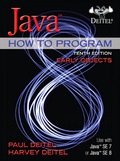
Concept explainers
(Computer-Assisted Instruction) The use of computers in education is referred to as computer-assisted instruction (CAI). Write a
How much is 6 times 7?
The student then inputs the answer. Next, the program checks the student’s answer. If it’s correct, display the message "Very good!" and ask another multiplication question. If the answer is wrong, display the message "No. Please try again." and let the student try the same question repeatedly until the student finally gets it right. A separate method should be used to generate each new question. This method should be called once when the application begins execution and each time the user answers the question correctly.
Want to see the full answer?
Check out a sample textbook solution
Chapter 6 Solutions
Java How To Program (Early Objects)
 C++ Programming: From Problem Analysis to Program...Computer ScienceISBN:9781337102087Author:D. S. MalikPublisher:Cengage Learning
C++ Programming: From Problem Analysis to Program...Computer ScienceISBN:9781337102087Author:D. S. MalikPublisher:Cengage Learning
